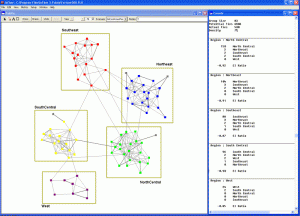Top 30 Social Network Analysis and Visualization Tools
We review major tools and packages for Social Network Analysis and visualization, which have wide applications including biology, finance, sociology, network theory, and many other domains.
-
InFlow performs network analysis AND network visualization in one integrated product. It is one of the early tools in SNA which has survived because of its ease of use and interactive interface. It is a bit more pricey, but it comes with coaching and support by Valdis. You need to contact Valdis (you can do so through this web site) for current pricing and features.
-
JUNG(Java Universal Network/Graph Framework) is a software library that provides a common and extensible language for the modelling, analysis, and visualization of data that can be represented as a graph or network. The JUNG architecture is designed to support a variety of representations of entities and their relations, such as directed and undirected graphs, multi-modal graphs, graphs with parallel edges, and hypergraphs. It provides a mechanism for annotating graphs, entities, and relations with metadata.
-
Keynetiq is an innovative platform for Organizational Network Analysis. It’s designed to map, visualize and analyze networks of people and relations between them, revealing how organizations really operate in day-to-day business. It provide a complete range of services ranging from the analysis of your objectives and the design of an ONA study, implementation of the Keynetiq tool, coordination of data gathering and administration of the platform, right up to a full analysis of your organizational network and a detailed report complete with an action plan.
-
MeerKat offers facilities for automated community mining, various layout algorithms for helpful visualizations, and timeframe event analysis for dynamic networks that have been observed at multiple points in time. Meerkat carefully lays the network out on the screen to minimize occlusion and highlights communities. It also provides information about the most influential/central nodes within each community.
-
Netlytic is a cloud-based text and social networks analyzer that can automatically summarize large volumes of text and discover social networks from online conversations on social media sites such as Twitter, Youtube, blogs, online forums and chats. Multi-tier subscription including free version.
-
NetMiner is an application software for exploratory analysis and visualization of large network data based on SNA. It has embed internal Python-based script engine which equipped with the automatic Script Generator. NetMiner 4 license for coursework is provided to students and teachers.
-
Network Workbench is a Large-Scale Network Analysis, Modeling and Visualization Toolkit for Biomedical, Social Science and Physics Research. The envisioned data-code-computing resources environment will provide a one-stop online portal for researchers, educators, and practitioners interested in the study of biomedical, social and behavioral science, physics, and other networks.
-
NetworKit is a growing open-source toolkit for high-performance network analysis. Its aim is to provide tools for the analysis of large networks in the size range from thousands to billions of edges. For this purpose, it implements efficient graph algorithms, many of them parallel to utilize multicore architectures. These are meant to compute standard measures of network analysis, such as degree sequences, clustering coefficients and centrality. In this respect, NetworKit is comparable to packages such as NetworkX, albeit with a focus on parallelism and scalability.
-
NetworkX is a Python language software package for the creation, manipulation, and study of the structure, dynamics, and functions of complex networks. With NetworkX you can load and store networks in standard and nonstandard data formats, generate many types of random and classic networks, analyze network structure, build network models, design new network algorithms, draw networks. It is used by mathematicians, physicists, biologists, computer scientists, and social scientists.
-
NodeXL is a free, open-source template for Microsoft® Excel® that makes it easy to explore network graphs. With NodeXL, you can enter a network edge list in a worksheet, click a button and see your graph, all in the familiar environment of the Excel window. Flexible Import and Export Import and export graphs in GraphML, Pajek, UCINet, and matrix formats. Direct Connections to Social Networks Import social networks directly from Twitter, YouTube, Flickr and email, or use one of several available plug-ins to get networks from Facebook, Exchange, Wikis and WWW hyperlinks.
-
Pajek is a program, for Windows, the main motivation for development of Pajek was the observation that there exist several sources of large networks that are already in machine-readable form. Pajek should provide tools for analysis and visualization of such networks: collaboration networks, organic molecule in chemistry, protein receptor interaction networks, genealogies, Internet networks, citation networks, diffusion (AIDS, news, innovations) networks, data-mining (2-mode networks), etc. It is extensively used in academic research.
-
Polinode is a flexible tool that helps cut through complexity. At its core is the ability to map, visualize and analyze network data. Targeted mainly at organizations and consultants, applications range from identifying change agents and finding critical links through to promoting diversity and improving workplace layouts

